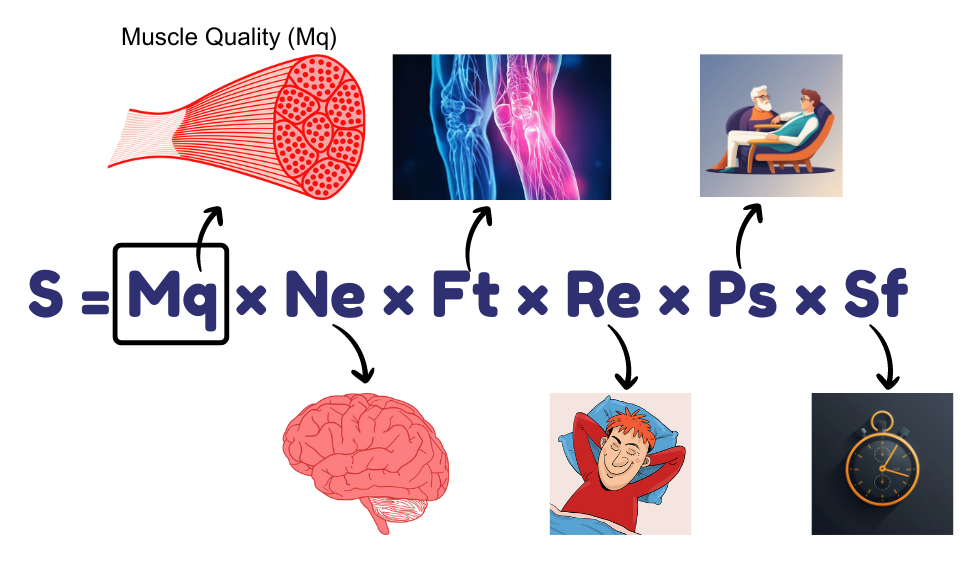In our first article, we introduced the Gainz Equation—a powerful tool for understanding the factors that contribute to strength, muscle growth, and power. Today, we’re diving deeper into one of its key components: Muscle Qualities (Mq). We’ll also explore the “Squish Effect,” a concept that might change how you think about size and strength.

What Is Muscle Qualities (Mq)?
Muscle Qualities (Mq) in the Gainz Equation represents the overall effectiveness of your muscle tissue in contributing to strength. It’s not just about how big your muscles are; it’s about what’s inside them. Specifically, Mq is influenced by:
- Muscle Fiber Type: The proportion of Type 1 (slow-twitch) and Type 2 (fast-twitch) fibers. Type 2 fibers are more powerful and contribute more to strength and explosive movements.
- Myofibrillar Density: This refers to the amount of contractile fibers within a muscle. Higher density means more fibers are pulling together during a contraction, increasing strength. Myofibrils are the actual contractile elements, while the sarcoplasm, which surrounds them, contributes to muscle volume without directly adding to strength.
- Muscle Cross-Sectional Area (CSA): Simply put, bigger muscles tend to be stronger, but it’s not just size that matters—it’s what that size is made of.
The “Squish Effect”
I think of tissue compression as the tissues surrounding a joint being squashed together as the joint bends. To visualize this, think of the tissue around the hamstrings meeting the back of the calves in a deep squat, for example. That’s what I call the “Squish Effect”—a phenomenon where the compression of tissues, both muscle and fat, around the joints provides added stability and support during heavy lifts.
This effect is particularly noticeable in exercises like the squat, bench press, and deadlift, where large amounts of muscle or fat can create a cushioning effect, aiding in force production at the bottom of the movement. It’s one reason why some larger athletes might be able to lift more, even if their muscle quality isn’t significantly higher.
So, the next time you see someone lifting more than you, just remember—they might just have a little extra help from the squish effect. You heard me, Chad. You’re only stronger than me because you’re not 3% body fat like I am!
Sarcoplasmic vs. Myofibrillar Hypertrophy
Understanding Mq also means understanding the types of hypertrophy that contribute to muscle growth:
- Myofibrillar Hypertrophy: Increases the density of contractile fibers in the muscle, contributing directly to strength.
- Sarcoplasmic Hypertrophy: Increases the volume of the sarcoplasm (the fluid and energy storage within the muscle cell). This type of growth contributes more to muscle size than to strength, which is why some big guys aren’t as strong as they look.
For bodybuilders, optimizing both types of hypertrophy is key to achieving maximum muscle size and a well-rounded physique. This balance can also play a role in other sports, particularly those with weight categories.
Applying Muscle Quality in Different Sports
While our main focus is on bodybuilding, Mq is also crucial in sports with weight categories, like boxing, wrestling, or powerlifting. In these sports, athletes need to maximize strength without adding unnecessary weight. Here’s how:
- For Strength Athletes: Focusing on myofibrillar hypertrophy can increase strength without adding much bulk, helping athletes stay within their weight class.
- For Endurance Athletes: Type 1 fibers are more fatigue-resistant and can be crucial for sports that require sustained effort. Training can be adjusted to emphasize these fibers without sacrificing overall muscle quality, and they might benefit from more sarcoplasm to handle increased glycogen storage and pH buffering.
The Role of Anabolic Steroids
It’s worth noting that anabolic steroids can influence Mq by disproportionately increasing the size of Type 2 fibers, which are more responsive to androgenic hormones. This can lead to an increase in muscle size and strength, but also potentially in the “Squish Effect,” as muscles become more filled with glycogen and water. The disproportionate growth in muscles like the trapezius and deltoids, which have higher concentrations of androgen receptors, might also explain why some people appear larger than their actual lifting numbers would suggest—these particular muscles create more of a perception of size than other muscles.
Conclusion
Muscle Quality is a cornerstone of the Gainz Equation and a critical factor in achieving your strength and hypertrophy goals. Whether you’re a bodybuilder aiming for maximum size or an athlete in a weight category sport, understanding and optimizing Mq will help you tailor your training for the best results.
Stay tuned for our next article, ‘Maximize Your Muscle Growth: How the Gainz Equation Targets Hypertrophy,’ where we’ll break down how to apply the Gainz Equation for optimal muscle gains. And remember, the Gainz Equation isn’t just a tool—it’s a way of thinking about your training, nutrition, and recovery in a whole new light.
David Crowther, also known as Dr. David Gainz, has over 32 years of experience in bodybuilding and a professional background as both a pharmacist and dentist. With a passion for science-backed training methods, David combines his extensive knowledge of human physiology with decades of hands-on experience in strength and hypertrophy training.
